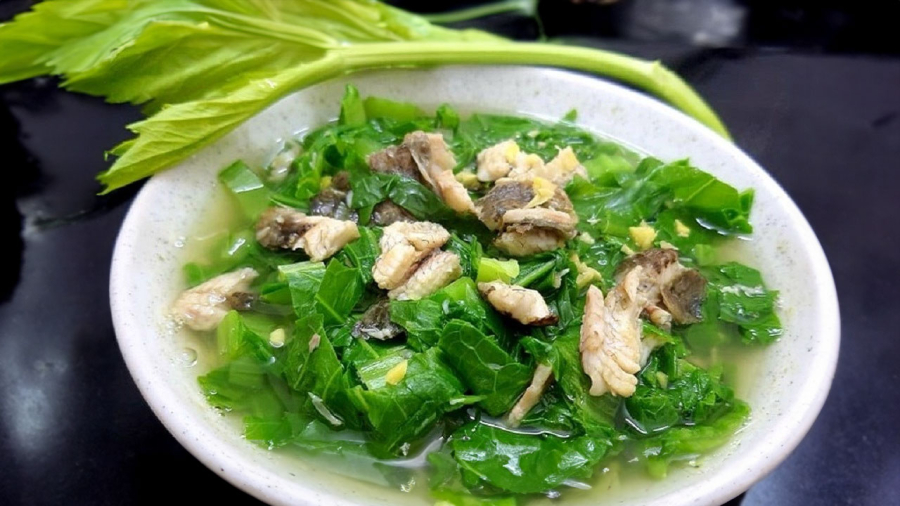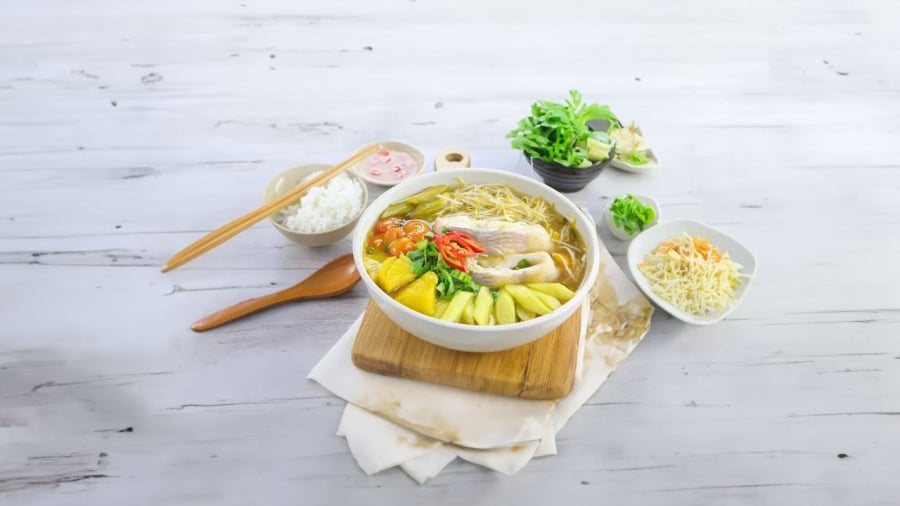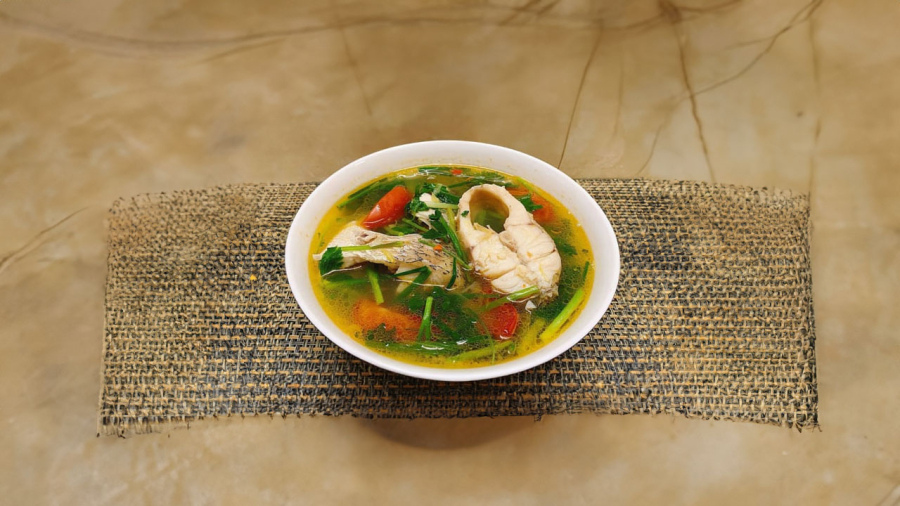Fish is a popular and nutritious food in Vietnamese meals. There are two main types of fish soup: sour soup (with sour flavors like tamarind, pineapple, tomato, or tamarind) or fish soup with green vegetables (using fish and vegetables without the sour flavors, mainly cooked with cabbage).
Fish soup varies from North to South with different cooking styles. Some places add turmeric as a characteristic spice, while others use fragrant pineapple, banana leaves, or spring onions. Some cook without using sour flavors, while others cook with bitter melon or green vegetables.
One common requirement for any type of fish soup is to ensure that the fish is fresh, the broth is clear, and there is no fishy smell. Remember these steps to ensure that the fish soup is never fishy:

Prep the fish to reduce fishy smell
Choose fresh fish that is cooked immediately to prevent it from becoming fishy, as fish is rich in protein, which, when dead for a long time, breaks down into substances that cause a fishy smell and can be harmful to the body.
Farm-raised fish, which are fed a lot of industrial feed, grow quickly and often tend to be fishier than wild fish.
When preparing the fish, scale it to remove dirt, clean it thoroughly, and especially remove the black membrane where a lot of dirt accumulates. The fins and tail of the fish should also be completely removed to remove any dirt.
To clean the fish, it is best to wash it with saltwater, ginger wine to reduce the fishy smell, and clean the blood and the black membrane inside the fish.
Always remember to use boiling water when cooking fish soup – a crucial tip to prevent the fish from becoming fishy and keep the meat tender and flavorful
When live fish comes into contact with boiling water, the fish meat contracts quickly, and the fish skin is quickly cooked, so it does not release a lot of amino acids, which cause fishiness. Many people often buy fresh fish to cook and still find it fishy because they make a mistake at this step. If you cook with cold water, the fish slowly cooks, and more amino acids are released, causing more fishiness, especially if you add cold water while cooking, the fishiness becomes even stronger.
Cooking fish in boiling water also helps the fish meat become sweeter and softer, without being flaky. This is because when fresh fish comes into contact with boiling water, the meat contracts quickly, so the protein inside the fish meat does not break down outside, helping the fish not become fishy and retaining its sweetness. When adding water, remember to add boiling water.
Cook the fish over medium heat
After boiling the water, put the fish in and let the pot come back to a boil, then reduce the heat to a simmer. Simmering the fish soup helps the fish cook evenly inside and absorb the flavors without becoming flaky. If you continue to use high heat, the fish soup will boil vigorously, and the pressure of the heat and boiling water will break down the protein structure in the fish meat, causing it to become flaky and releasing more amino acids into the water, resulting in fishy meat and a fishier broth.

Always remember to leave the lid slightly open when cooking so that the fish does not become fishy and the broth remains clear
Leaving the lid slightly open allows the amino acids to evaporate with the steam and not make the fish fishy. If you cover the pot tightly, the fish soup will become cloudy, and when you open it, it will be even fishier. The stagnant water on top of the lid then drips down, continuously causing fishiness. If you cover the lid when cooking with vegetables, the vegetables will lose their red color and aesthetic appeal.
Remember the supporting spices to enhance the aroma and flavor of the dish
A delicious fish soup will lose its taste and fragrance without the right spices. Depending on the region and cooking style, use suitable seasonings. For example, in Northern fish soup, aromatic herbs are essential. If cooking fish soup with vegetables, ginger and spring onions must be added, while sour fish soup must have a balance of sour and spicy flavors. In the Southern region, there is usually no shortage of laksa leaves… The leaves of laksa help create a sour and anti-fishy taste. The spices are also the ingredients that help reduce fishiness and enhance the fragrance of the fish soup.
Remember to add the herbs right before eating to avoid putting the herbs in and letting the fish soup sit for a long time before eating, as this will make the fish soup look unappetizing, with the herbs turning red and losing their fragrance, making the soup fishier.

Frying the fish before cooking to reduce fishiness?
This depends on each family’s taste. Many people believe that frying the fish first will increase the fatty flavor and reduce the mild flavor of the fish soup. In fact, lightly frying the fish is also a way to prevent fishiness. When frying, the fish comes into contact with very hot oil, so the fish skin contracts, reducing the release of amino acids into the water, thus reducing fishiness. This mechanism is similar to using boiling water to make the fish contract quickly and prevent fishiness. However, when frying the fish before cooking, it will add a greasy and pungent flavor to the fish soup, which is not as refreshing as when the fish is not fried. Fried fish touched high heat and has a fried smell, so the fish soup will have a different aroma than the aroma of non-fried fish. Putting lightly fried fish into the fish soup will make it fragrant, but it will smell like oil, creating a hotter sensation. On the other hand, non-fried fish has a lighter, fresher aroma. So choose the cooking method according to your taste.
Fish soup is a simple dish but it is a familiar and nutritious dish for many families, so you can try different ways of cooking and different styles of seasoning for your family to enjoy. As for sour fish soup, each time you cook, you can cook it in a regional style to create a unique flavor!
Maximizing Durability and Energy Efficiency with High-Speed Kettles: Tips and Advice
Are you an electric kettle aficionado? If so, you’ll appreciate Ði?n máy Xanh’s latest offering. We’ve compiled comprehensive instructions to help you make the most of your electric kettle, including tips on how to prolong its life as well as maximize energy savings. Let’s get your kettle expertise up to date!






































